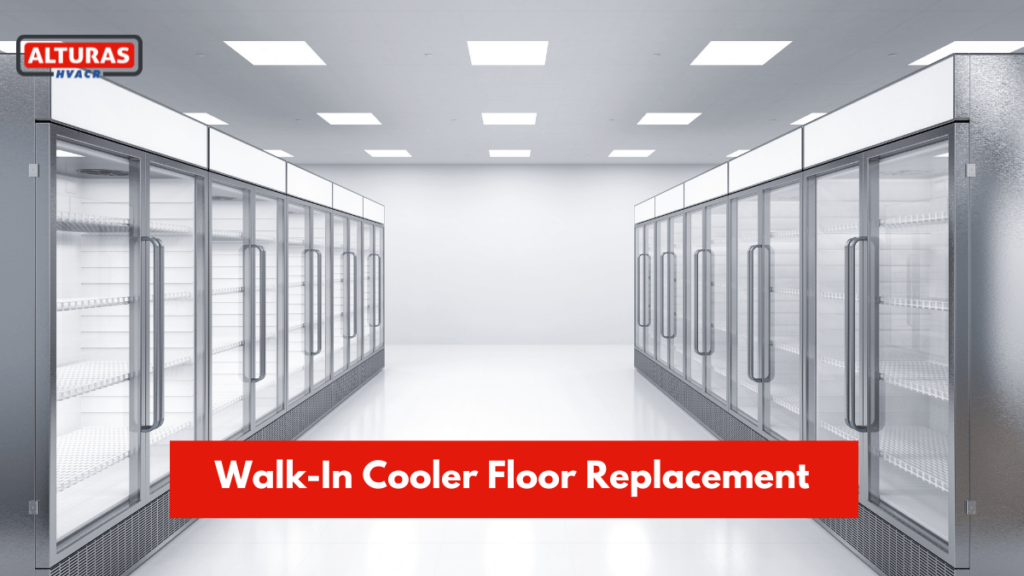Walk-in coolers and freezers are essential for businesses that need to store perishable items. However, the flooring of a walk-in cooler is just as important as the walls and refrigeration system. Over time, floors can degrade, reducing efficiency and safety. Whether you’re dealing with wear and tear or planning to upgrade. Understanding walk-in cooler floor replacement is crucial. This guide provides expert insights into walk in cooler floor replacement. This will include insulated flooring, replacement steps, and maintenance tips to ensure your walk-in cooler operates optimally.
How to Replace a Walk-In Cooler Floor?
A walk in cooler floor replacement involves completely removing the existing floor, including any insulation, down to the subfloor, then installing a new layer of insulation and a specialized flooring panel designed to withstand the cold temperatures and weight distribution within the cooler, typically requiring the expertise of a commercial refrigeration technician to ensure proper installation and sealing.
Key steps in a walk-in cooler floor replacement:
- Removal of old floor: Carefully dismantle the existing floor panels, removing all insulation material until you reach the subfloor of the cooler.
- Subfloor assessment: Inspect the subfloor for any damage or irregularities that need repair before installing new insulation.
- New insulation layer: Install a fresh layer of insulation specifically designed for cold environments, ensuring proper thickness depending on the desired temperature of the cooler.
- Plywood installation: Lay down pre-sealed plywood panels, ensuring proper overlap between sheets for even weight distribution.
- Finish flooring application: Install the chosen floor panel, which can be made from aluminum, stainless steel, or a textured material with a non-slip surface, depending on the intended use of the cooler.
Important considerations for walk-in cooler floor replacement:
- Traffic type:Select a floor panel capable of handling the weight of items stored in the cooler, whether it’s light foot traffic, hand trucks, or pallet jacks.
- Sealing:Pay close attention to sealing all seams and joints to prevent moisture and condensation from accumulating.
- Professional installation:Due to the specialized nature of the work, it’s highly recommended to hire a qualified refrigeration technician to perform the floor replacement
Do Walk-In Coolers or Freezers Need an Insulated Floor?
Yes, insulated floors are vital for walk in coolers and freezers. Insulated floors help maintain consistent temperatures by reducing heat transfer from the ground. In freezers, where temperatures are significantly lower, insulation prevents frost buildup and ensures energy efficiency. Without an insulated floor, your refrigeration system works harder, increasing energy costs and risking equipment wear.
For coolers with minimal temperature requirements, concrete flooring may suffice, but adding insulation improves efficiency. For freezers, an insulated floor is non-negotiable to meet operational standards and reduce maintenance issues.
How Do You Insulate a Walk-In Cooler Floor?
Insulating a walk-in cooler floor involves several steps to ensure long-lasting performance:
- Preparation: Clear the floor area and clean it thoroughly. Ensure no debris or moisture is present before proceeding.
- Vapor Barrier Installation: Lay a vapor barrier to prevent moisture infiltration, which can damage insulation and flooring materials.
- Insulation Material: Use high-quality foam panels or rigid insulation boards. These materials are designed to handle low temperatures and resist compression.
- Thermal Breaks: Add thermal breaks to prevent cold air from escaping and minimize condensation along the edges of the floor.
- Finish Layer: Place a durable flooring material, such as aluminum diamond tread or concrete, over the insulation to protect against wear and support heavy traffic loads.
Flooring Options for Commercial Walk-In Coolers and Freezers
When selecting a flooring option for your walk-in cooler, consider factors like traffic load, insulation needs, and durability. Here are some popular options for walk in freezer flooring:
Pre-Fabricated Floors (Rated for Foot Traffic)
Pre-fabricated floors are convenient and easy to install. These panels are insulated and come with durable surfaces that can handle moderate foot traffic. They’re ideal for businesses needing quick replacements.
NSF-Approved Floors
NSF-approved floors meet strict hygiene standards. They include:
- NSF Cove Formed Floors: Seamless designs that prevent bacteria buildup.
- Foamed-in-Place Panels: These panels are pre-insulated and provide excellent thermal efficiency.
Wear Surfaces
Wear surfaces enhance durability and include:
- Smooth Aluminum: Ideal for light traffic areas.
- Low-Profile Aluminum Diamond Tread: Provides better grip and durability for heavy-duty use.
Reinforced Floor Panels
These panels include:
- 1/2” Plywood Underlayment: Suitable for hand trucks.
- 3/4” Plywood: Designed for manual pallet jacks and heavier loads.
Insulated Concrete Floors
For high-traffic areas exceeding 950 pounds per square foot, insulated concrete floors are recommended. These floors require professional installation, including vapor barriers and thermal breaks, for optimal performance.
Drop-In Floors
Drop-in floors are perfect for retrofitting existing coolers. They can replace failing floors or convert a cooler into a freezer without disassembling the chamber.
Are There Any Post-Installation Tips for Maintaining/Cleaning?
Proper maintenance ensures your new floor lasts longer and remains efficient. Follow these tips:
- Regular Cleaning: Use non-abrasive cleaners to remove dirt and debris. Avoid using harsh chemicals that could damage the surface.
- Inspect Seals: Check floor seals regularly for cracks or wear and reapply sealant as needed.
- Monitor Moisture Levels: Keep an eye out for moisture accumulation, which can lead to insulation damage.
- Avoid Overloading: Follow weight limits specified for your flooring to prevent damage.
- Professional Inspection: Schedule periodic inspections by professionals to identify potential issues early.
Get Professional Help for Replacement from Alturas Contractors
Replacing or upgrading a walk-in cooler floor is a significant investment. Alturas Contractors offer commercial walk in cooler installation services, provide customized solutions to meet your business needs. From prefabricated panels to insulated concrete floors, we provide expert installation services with a focus on quality and efficiency. Contact us today for a consultation.
Conclusion
Walk-in cooler floor replacement is essential for maintaining efficiency, safety, and hygiene. Over time, flooring damage from heavy pallet jacks and foot traffic can compromise the integrity of your cooler. Ensuring proper insulation, durable materials, and professional floor repair can extend the life of your walk-in coolers and freezers. Whether you’re replacing a walk-in cooler floor due to wear and tear or upgrading for better performance, consider factors like traffic load, durability, and cost to make the best decision.
Walk-In Cooler Floor Replacement FAQs
What is the best flooring for a walk-in cooler?
Prefabricated panels and reinforced aluminum diamond tread are excellent options for durability and insulation.
Is a concrete floor ok for a walk-in cooler?
Yes, but it should include insulation and a vapor barrier for optimal performance.
What is the best material for inside a walk-in cooler?
Aluminum diamond tread or smooth aluminum with proper insulation is recommended.
What is the life expectancy of a walk-in cooler?
With proper maintenance, a walk-in cooler can last 10-20 years.
What is walk-in cooler floor replacement cost?
Costs vary based on size, materials, and labor.
What is walk-in cooler floor epoxy?
Epoxy flooring is a durable coating that protects against moisture, wear, and bacteria.
What is the best walk-in cooler floor replacement option?
Prefabricated insulated panels with aluminum diamond tread are popular for durability and ease of installation.
What are walk-in cooler floor paints?
Specialized epoxy paints designed for low-temperature environments are commonly used.
What is rubber flooring for walk-in coolers?
Rubber flooring provides slip resistance and durability, suitable for light to moderate traffic areas.
Does a walk-in cooler need a floor drain?
A floor drain is recommended for easy cleaning and to manage condensation or spills.
Which flooring is best suited for cold climates?
Insulated flooring with thermal breaks and vapor barriers performs best in cold climates.
What do you line a walk-in cooler with?
Line with insulated panels or NSF-approved materials to ensure hygiene and efficiency.
How do I keep moisture out of my walk-in cooler?
Ensure proper seals, use a vapor barrier, and regularly inspect for condensation buildup.

